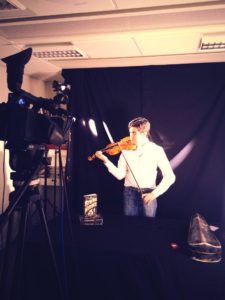Books
All the strings to The Strings Of Murder
The Strings of Murder, the debut novel from Oscar de Muriel, is a ghostly locked room mystery set in Victorian Edinburgh.
The novel sees Detective ‘Nine-Nails’ McGray and Inspector Ian Frey investigate the gruesome deaths of the successive owners of a violin allegedly played by the Devil meet gruesome deaths.
We asked Oscar where he found the inspiration for such an intriguing gothic mystery.
There is never just one source of inspiration for a story. For my debut, The Strings Of Murder, I found that I had unconsciously been collecting bits and pieces throughout my life, from places I visited, to people I met, to fiction as diverse as the X-Files to The Woman In White.
Growing up in Mexico City, I spent the greater part of my teens reading Victorian and Gothic fiction. I was simply drawn to them without really knowing why. The Black Cat by Edgar Allan Poe was one of my early favourites. I vividly remember my sister reading it aloud, and even though I was quite scared I had to hear how it ended. Dracula, despite being well over a century old, still has some of the most disturbing and chilling scenes I’ve ever read.
However, any work of Victorian detective fiction is bound to be indebted to one figure beyond all others. I would spend long evenings cuddling up with my Sherlock Holmes paperbacks, trying to work out the clues and beat him to solving the mysteries – which I only managed once.
The Hound of the Baskervilles is still, hands down, my favourite and was a big touchstone for The Strings Of Murder. Out of the Holmes novels it has the best thought-out plot, in my opinion, the most atmospheric descriptions of the manor and the surrounding moors, and all those hints at the supernatural which I particularly enjoyed.
 In this respect, Sir Arthur Conan Doyle is a very good illustration of the two sides of the Victorian psyche I want to contrast in this series. On the one side he wrote all these watertight works of detective fiction where his hero relies entirely on deduction, observation and rational thinking; but on the other hand, Doyle had a renowned interest in the occult and spiritualism after a series of family tragedies – he actually believed in fairies and claimed to converse with the spirits of the dead!
In this respect, Sir Arthur Conan Doyle is a very good illustration of the two sides of the Victorian psyche I want to contrast in this series. On the one side he wrote all these watertight works of detective fiction where his hero relies entirely on deduction, observation and rational thinking; but on the other hand, Doyle had a renowned interest in the occult and spiritualism after a series of family tragedies – he actually believed in fairies and claimed to converse with the spirits of the dead!
I find this conflict fascinating, and it was fertile ground when developing the backstory of ‘Nine-Nails’ McGray, the Scottish half of my detective duo. The thought of someone facing a shocking tragedy and trying to find ways of coping with it, resorting to the most outlandish justifications as a defence mechanism really appealed to me.
Another very important element I wove into his personality was the Scottish background. It was minutes after I came up with the main premise of the series that I knew Edinburgh, one of my favourite cities in the world (apologies to my Glaswegian fiends!), was the ideal setting. Besides being outstandingly beautiful, its architecture, atmosphere and history all make it the perfect location for an ‘is-it-or-isn’t-it?’ supernatural mystery such as this.
When I had to decide how to narrate the book I tried out several points of view. I love the witty, utterly English style of P.G. Wodehouse, so I decided to tell the story from the point of view of ‘Nine-Nails’ McGray’s sidekick, Inspector Ian Frey. I made him a very snobbish, aristocratic Londoner, obsessed with manners and protocol, who thinks he is driven purely by reason.
Now I had my detective duo, all I needed was a first case to give them, and again I found inspiration in my teenage years.
As a violin player I was well aware of the spooky legends around a baroque piece of music named ‘The Devil’s Trill Sonata’. The 18th century composer Giuseppe Tartini dreamt the devil visited him in the night, picked up his violin and played the most beautifully insidious music he’d ever heard. Tartini woke up and immediately tried to write down what he could remember. The piece was revolutionary, but Tartini claimed, to the day of his death, that it was nothing compared to what the devil had played.
I spent ten years thinking of the best way to weave that into a story that would do it justice. That myth is central to the locked room murder of a virtuoso violinist in Victorian Edinburgh, which begins the first case for Frey and McGray in The Strings Of Murder.
This extract is taken from the audiobook edition of The Strings of Murder. Find out more here.
1 Comment
Join the discussion
Please note: Moderation is enabled and may delay your comment being posted. There is no need to resubmit your comment. By posting a comment you are agreeing to the website Terms of Use.

A new and refreshing take on the Victorian crime novel, funny, tense, dramatic with a fabulous period feel. This has a strong hint of more to follow and I cannot wait!